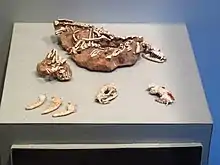Pucadelphys
Pucadelphys is an extinct genus of non-marsupial metatherian species.[1][2][3][4] The genus contains a single species, P. andinus. Fossils of Pucadelphys have been found in the Santa Lucía Formation in Tiupampa in Bolivia.[5]
| Pucadelphys | |
|---|---|
 | |
| Fossils from Bolivia | |
| Scientific classification | |
| Kingdom: | Animalia |
| Phylum: | Chordata |
| Class: | Mammalia |
| Clade: | Marsupialiformes |
| Genus: | †Pucadelphys Marshall & De Muizon 1988 |
| Type species | |
| Pucadelphys andinus Marshall & De Muizon 1988 | |
Description
Pucadelphys was small and likely to have eaten insects. It had a long tail, although incomplete on the best preserved fossils. It is possible that the tail was longer than (or at least as long as) its body. 17 vertebrae were preserved, and its estimated that there was 5 to 10 additional vertebrae originally. It is regarded as partially arboreal, and partially terrestrial.
Taxonomy
A 2016 phylogenetic analysis recovered Pucadelphys as a member of a metatherian clade including sparassodonts and other South American taxa, but not marsupials (which are instead closer to Cretaceous North American species). The phylogenetic tree from the analysis is shown below.[6]
| Marsupialiformes |
| ||||||||||||||||||||||||||||||||||||||||||||||||||||||||||||||||||||||||||||||||||||||||||||||||
References
- Guillermo W. Rougier, John R. Wible and Michael J. Novacek. First Implications of Deltatheridium specimens for early marsupial history, Nature 396, 459-463(3 December 1998)
- S. Bi, X. Jin, S. Li and T. Du. 2015. A new Cretaceous metatherian mammal from Henan, China. PeerJ 3:e896
- Guillermo Rougier, New specimen of Deltatheroides cretacicus (Metatheria, Deltatheroida) from the Late Cretaceous of Mongolia, BULLETIN OF CARNEGIE MUSEUM OF NATURAL HISTORY 36(DEC 2004):245-266 · SEPTEMBER 2009
- Guillermo W. Rougier; Brian M. Davis; Michael J. Novacek (2015). "A deltatheroidan mammal from the Upper Cretaceous Baynshiree Formation, eastern Mongolia". Cretaceous Research. 52, Part A: 167–177. doi:10.1016/j.cretres.2014.09.009.
- Pucadelphys at Fossilworks.org
- Wilson, G.P.; Ekdale, E.G.; Hoganson, J.W.; Calede, J.J.; Linden, A.V. (2016). "A large carnivorous mammal from the Late Cretaceous and the North American origin of marsupials". Nature Communications. 7: 13734. Bibcode:2016NatCo...713734W. doi:10.1038/ncomms13734. PMC 5155139. PMID 27929063.
Further reading
- Brands, S.J. (comp.) 1989–2005. Systema Naturae 2000. The Taxonomicon. Universal Taxonomic Services, Amsterdam, Holanda.
- McKenna, M.C., y Bell, S.K. (1997), Classification of Mammals Above the Species Level., Columbia University Press, New York. 0-231-11013-8.
- Suárez Soruco, R. (2007) Bolivia y su Paleodiversidad Cuadernos del Museo Geominero, nº 8. Instituto Geológico y Minero de España, Madrid. ISBN 978-84-7840-707-1



